WESTERN ROMANCES
ELIZABETH TAYLOR ROCK HUDSON, AND JAMES DEAN IN GIANT


GARY COOPER, DORIS DAY, JAMES GARNER, ROBERT REDFORD, AND MORE SCREEN LEGENDS FROM OUR FAVORITE LOVE STORIES

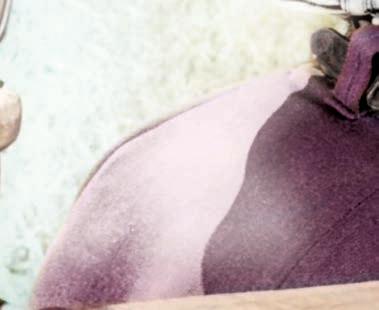
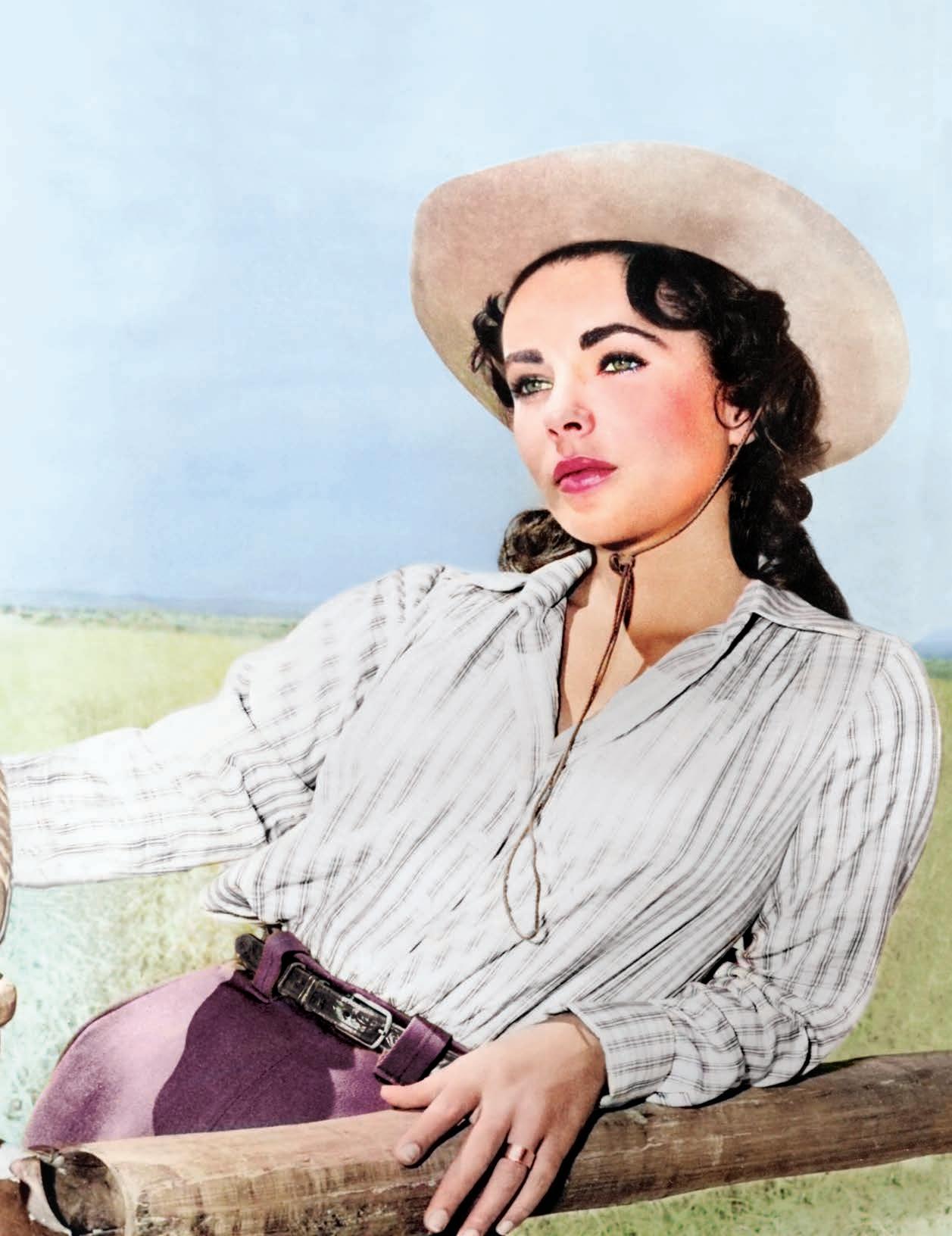
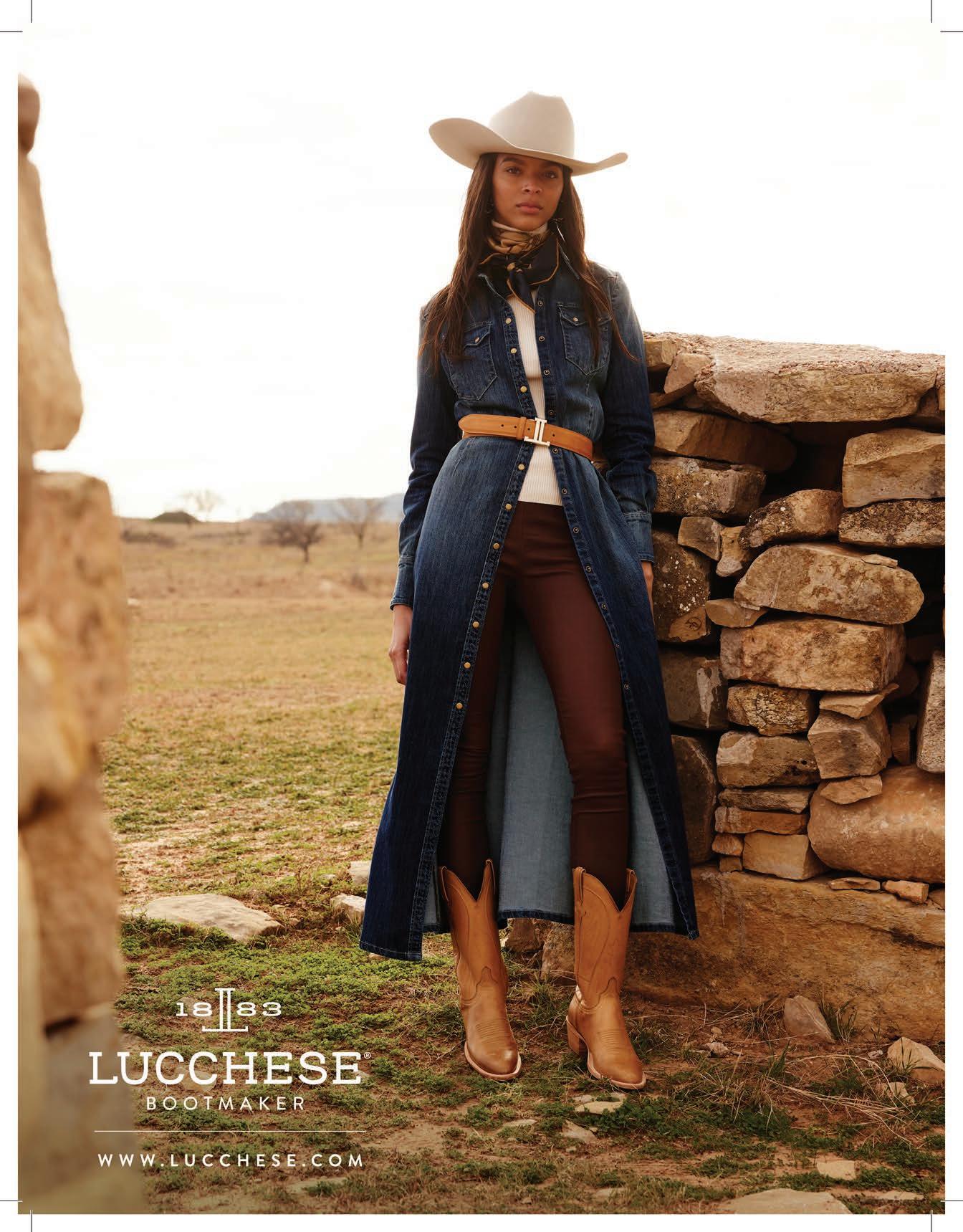



GARY COOPER, DORIS DAY, JAMES GARNER, ROBERT REDFORD, AND MORE SCREEN LEGENDS FROM OUR FAVORITE LOVE STORIES




By C&I Editors
Her name is synonymous with glamour. She is often remembered as one of the biggest movie stars of the 20th century, sharing (and often stealing) scenes with the likes of Paul Newman, Montgomery Clift, Lee Marvin (remembered on page 60), Rock Hudson, and James Dean.
And yet, despite the formidable on-screen company she kept, we’d never considered the screen legend for the cover of our publication. Until now.
Elizabeth Taylor. An icon yes. A western star not exactly.
But when writer David Hofstede turned in his feature article on favorite western romances (page 84), it dawned on us: What about Elizabeth Taylor in Giant? It was like daybreak. Of course Elizabeth Taylor in Giant. With her costars Hudson and Dean, Taylor helped deliver an epic lm adapted from Pulitzer Prize-winning author Edna Ferber’s novel a “sprawling tale,” as many described it, that continues to resonate with audiences today.
After it premiered in 1956, Giant earned 10 Academy Award nominations, including a second Best Director win for George Stevens. In her role as Leslie Benedict, the well-heeled Maryland-born wife of wealthy Texas rancher Jordan “Bick” Benedict Jr. (Hudson), Taylor leads viewers through this sweeping generational drama from her character’s perspective.
“She is tender and yet stubborn,” said one review in Variety at the time, “a surprisingly clever performance that registers up and down the line.”
Taylor’s star power and, dare we say, grit in Giant more than registers all these years later. It was an astonishing role for the then-23-yearold, who would cinematically age 25 years over the course of the story, and the performance would become one of the most critically acclaimed of her career. It had staying power, and so do stills of her from the lm and from the set. With her extraordinary beauty against the backdrop of dusty West Texas, those images continue to captivate to the point of breathlessness.

There’s plenty of substance, of course, under all the style, but what style! Martin Scorsese claims to have watched the lm dozens of times. “As far as lmmaking goes,” Scorsese has been quoted, “Giant is an inspiring lm. I don’t mean morally, but visually. It’s all visual.”
While we wouldn’t got so far as to say this edition of C&I is all visual, it is our annual Style issue, and there’s plenty of it in many forms: Liz’s unforgettable look on the cover, Western fashion (pages 40 and 92), modern interior design (page 50), Indigenous runway looks (page 70), historic regalia (page 104), a musician’s vintage wardrobe (page 110), and the vibrant out ts of escaramuza charras (page 126).
British Vogue declared that “Elizabeth Taylor remains one of Hollywood’s most enduring style icons.” We couldn’t agree more. And we’d like to keep the conversation going. Who are your style icons? Who would you like to see on the cover? What are some of your favorite stylish and romantic westerns? Write to us at letters@ cowboysindians.com to let us know.
Because sharing our stories about the West and our love for this singular place and state of mind will never go out of style. H
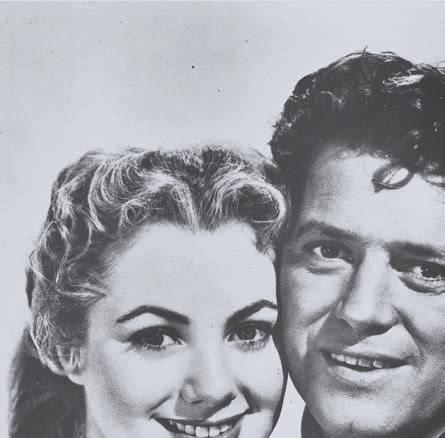




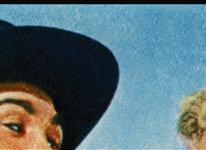





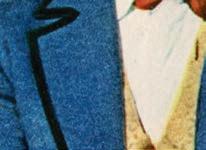





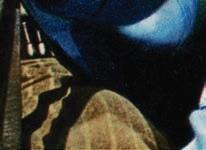

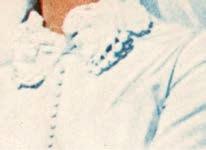

































































Start with a Giant portion of epic West Texas drama—then load up on plenty more westerns where love rules the range.


By David Hofstede

Elizabeth Taylor, Rock Hudson, and James Dean star in George Stevens’ beloved western drama, going deep into the three Rs of the epic Texas tale: Reata, relationships, and the complicated romance of the West.
e’s an unapologetically Alpha Male Texan, owner of a cattle ranch large enough to make John Dutton jealous, and accustomed to women (except for his domineering sister) and Mexican laborers knowing their place. She’s a strong-willed Maryland socialite with progressive opinions— especially when it comes to the exploitation of Mexican laborers— and an independent streak wider than a country mile. By the way: She knows next to nothing about cattle, ranching, or Texas.So of course they’re made for each other, right?
In the world according to Giant, director George Stevens’ classic 1956 lm based on Edna Ferber’s bestselling 1952 novel, opposites instantly attract, marry hastily, and maintain ties strong enough to withstand sporadic disputes over the course of decades together (despite a few months of estrangement). And because the unlikely partners are charismatically portrayed by Elizabeth Taylor and Rock Hudson, audiences have continued to have a rooting interest in the preservation of their union for as long as the movie has been available for viewing on screens large and small.
Covering a period from the 1920s to the post-World War II years, Giant is a sprawling and spectacular saga that focuses on the intersecting lives of Jordan “Bick” Benedict Jr. (Hudson), the tradition-bound owner of the Reata Ranch, a massive spread of “around a half-million acres” in West Texas; Leslie Lynnton Benedict (Taylor), his Marylandborn wife, whom Bick meets-cute while he’s in her area on a horse-buying trip, and who gradually acclimates herself to the rigors of Texas ranch life but never fully accepts the casual racism (directed at Mexican laborers and neighbors) or ingrained sexism of her husband and his good-ol’-boy buddies; and Jett Rink (James Dean), a moodily insolent ranch hand who is bequeathed a small patch of land by Bick’s spinster sister, Luz (Mercedes McCambridge), becomes a zillionaire when he strikes oil on his property — and nurses a serious crush on Leslie (who, it should be noted, does not deliberately encourage his attention).
marries a Mexican-American beauty, Juana (Elsa Cárdenas), and fathers Jordan Benedict IV. But Jett — a character Edna Ferber modeled after real-life Texas oil tycoon Glenn McCarthy —is never fully satis ed after amassing his immense fortune and continues to nurture his unrequited love for Leslie even after he starts to woo her daughter (Carroll Baker). Sigmund Freud likely would have had a eld day with that love story.

Six decades after its initial release, Giant can be viewed as a strong in uence on everything from the prime time soap operas Dallas (both the original and the reboot) and Dynasty (which brie y featured Rock Hudson as a series regular) to movies as diverse as Kevin Reynolds’ Fandango (in which a young Kevin Costner and some friends visit Marfa, Texas, to see the crumbling remains of the Reata Ranch house set) to Robert Altman’s Come Back to the 5 & Dime Jimmy Dean, Jimmy Dean. (Dean died in an auto crash less than a week after completing his work on Giant; during post-production, director Stevens employed actor Nick Adams to overdub some of Dean’s dialogue.) And nowhere is it treasured more than in the Lone Star State, where it remains known as “the national lm of Texas.” The reason for its enduring appeal? As Don Graham notes in his indispensable book Cowboys and Cadillacs: How Hollywood Looks at Texas, “The moral equation of Giant is the most sentimental and cherished in Texas mythology: a preference for the ranching tradition as against the wheeler-dealer world of wildcatters and gushers. As a modern western, Giant succeeded so well because it a rmed for Texans and the nation the old-fashioned virtues of pastoral ranching, cowboying, yes-ma’aming and no-ma’aming, [and] raising prize-winning cattle on the open plains.”
Yes, it’s true: Giant is at heart an epic love story, but it’s also a tale of a romantic triangle.
Slowly but surely, with a good deal of prodding by his wife, Bick becomes a better and more racially enlightened person, especially after his son, Jordan Benedict III (Dennis Hopper),
At the same time, though, Giant also takes a wider view of life and love by celebrating long-term marriage as one of life’s great adventures. Under ordinary circumstances, Bick and Leslie probably would have nothing to do with each other. And even if they did, well, the initial spark of romance would burn out pretty quickly. But let’s face it: We generally don’t watch movies to see ordinary people doing ordinary things. And you rarely nd a couple more extraordinary than Elizabeth Taylor and Rock Hudson in Giant.
—Joe Leydon
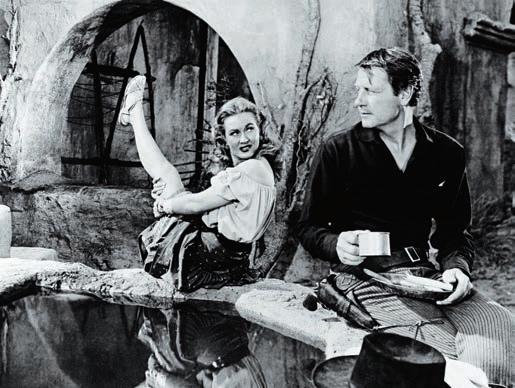
Do love and cowboys mix? They do in these rootin’-tootin’, shootin’, and smoochin’ westerns.
By David Hofstede
In one of their many lm appearances together, Roy Rogers kissed his wife and costar Dale Evans on the forehead. After that, the studio received sacks of letters telling them to “leave the mushy stu out.”
Such is the dilemma of romance in westerns. Many of the classics may o er a love story as a subplot: Ringo and Dallas in Stagecoach, Wyatt Earp and Clementine in
My Darling Clementine, Sundance and Etta (and maybe Butch) in Butch Cassidy and the Sundance Kid. However, many fans don’t care if the hero gets the girl as long as the bad guy winds up face down in the mud.
But romance devotees need not avoid the genre altogether. Here are movies with love stories at the forefront — with or without the mushy stu .
“You and I are poles apart. If you really knew me you wouldn’t like me at all. And yet I’d rather be with you than anyone else.”
Can a hard-partying Florida society girl nd lasting happiness with a humble, slowtalking rodeo cowboy? A romantic comedy like The Cowboy and the Lady wouldn’t have it any other way — though it takes its mismatched couple a while to get there (91 minutes, to be exact).
Gary Cooper plays Stretch Willoughby, who is set up on a blind date with Mary Smith (Merle Oberon). During their time together she pretends to be a maid with a tragic past instead of a wealthy socialite. Stretch is so moved that the next day he proposes marriage. She quickly turns him down — and he tosses her in a swimming pool. But truths are revealed eventually, along with true feelings, in this breezy culture-clash yarn.
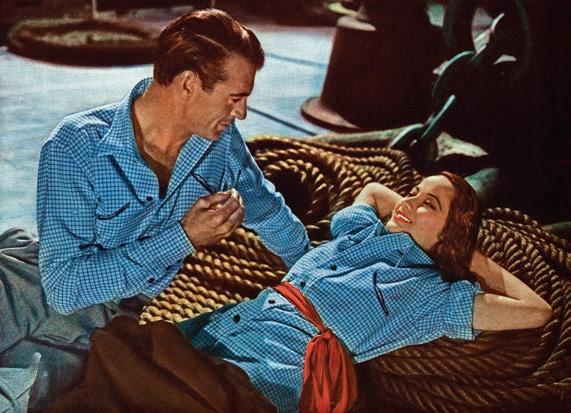

“Did you ever think you’d like to travel a long way o ...as far and as high as the moon...and stay there for good...forever...and forget all about things down here?”
Unrequited love is certainly the most painful kind of all, and Raoul Walsh’s Colorado Territory explores three such tragic romances, amidst a fast-paced story about escaped outlaw Wes McQueen (Joel McCrea) hoping to retire after one last train robbery. During a stagecoach trek to reunite with his former boss, Wes meets Julie Ann (Dorothy Malone), who has moved west with her father to start a new life. He is attracted to her, but her father tells Wes that her heart belongs to Randolph, who refuses to marry her. While Wes pines for the love and the better life she represents, his gang of bandits is joined by Colorado Carson (Virginia Mayo), a half-Indian woman who falls for him. Does anyone get a happy ending? Sadly, not in this remake of High Sierra (1940), also directed by Walsh.
“At last my heart’s an open door. And my secret love’s no secret anymore.”
The most famous historical Old West romance was that of Wild Bill Hickok and Calamity Jane — though many historians doubt their relationship ever extended beyond irtation. But it makes for a great story, one that inspired several lms, including The Plainsman (1936) and Wild Bill (1995). Calamity Jane sets their romance to music, with Doris Day as the titular heroine and Howard Keel as Hickok. While both pursue other relationships for most of the lm, they nally acknowledge their true feelings in time for a wedding before the closing credits.
Keel, having already played Frank Butler in Annie Get Your Gun, seemed right at home in a western musical romance, and the alwaysladylike Doris Day is (somewhat surprisingly) delightful as a frontier wildcat in buckskins. And who could forget Doris singing the sublime Oscar-winning hit “Secret Love”?


“Don’t throw bouquets at me. Don’t please my folks too much. Don’t laugh at my jokes too much. People will say we’re in love.”
Musicals lend themselves more naturally to romance than westerns, so it’s not surprising to nd that cowboys who sing and dance are more likely to fall in love. The landmark 1943 stage musical Oklahoma! was adapted into an equally impressive lm featuring an iconic Oscar-winning score by Richard Rodgers and Oscar Hammerstein. The choreography by Agnes de Mille was revolutionary for its time, particularly in the dream ballet that dramatizes the romance between Laurey (Shirley Jones, in her lm debut) and ranch hand Curley (Gordon MacRae), which is complicated by Curley’s brutish rival, Jud (Rod Steiger).


Murphy: “I’m in love for the last time in my life.”
Emma: “I’m in love for the rst time in my life.”
Emma (Sally Field) relocates with her son to a small Arizona town after a bitter divorce. There, she meets Murphy (James Garner), drugstore proprietor, country philosopher, and Old World gentleman. He likes what he likes and feels no need to keep up with the modern world — that’s why he still drives a 1930 Studebaker and hasn’t gone to a movie “since the Duke died.” But when Emma walks into his store, he sees a way to change his life for the better.
Murphy’s Romance pairs two of the screen’s most charismatic stars, turning them loose in a story where the ending is easily guessed, but the journey to get there is still delightful. The complication that arises when Emma’s slacker ex-husband arrives is only there to delay the inevitable.

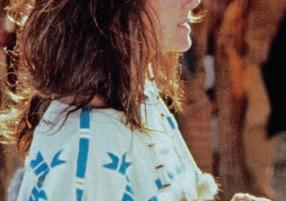





“My place is with you. I go where you go.”
There are many reasons why Dances With Wolves is a very special lm, from its authentic portrayal of the culture and language of the Lakota Sioux to director-star Kevin Costner’s determination to make the movie his way, which required him to write a $3 million check to get it done. While it is primarily a redemption tale, in which Army o cer John Dunbar nds a new and better life among the Lakota, it is the romance between Dunbar and the Native woman Stands With a Fist (Mary McDonnell) that gives the story its heart.
In the lm’s nal moments, as they head o together after so many harrowing encounters with Pawnees and soldiers, viewers undoubtedly hoped they were riding toward a happy ending. While author Michael Blake’s sequel to Dances With Wolves was never lmed, the story does reveal that the couple stayed together and became parents to three children — until the world outside their tribe once again came calling.

“ Tristan, I have nowhere to send this letter and no reason to believe you wish to receive it. I write it only for myself. And so I will hide it away along with all the things left unsaid and undone between us.”
Samuel (Henry Thomas) returns to the remote Montana ranch of his father (Anthony Hopkins) with his ancée, Susannah (Julia Ormond). When Susannah’s eyes lock with Samuel’s older brother, Tristan (Brad Pitt), a mutual passion is ignited. But Susannah ends up marrying a third brother, Alfred (Aidan Quinn).
It’s not as sordid as it sounds, though the melodrama label is not as easily avoided. Still, Ormond is captivating, Pitt proved he’s more than a handsome face, and John Toll’s photography deservedly won an Oscar. How does it end? Fans still debate whether they got it right, but the death of Tristan’s eventual bride and mother of his children, Isabel Two (Karina Lombard), adds yet another element of romantic tragedy that’s almost Shakespearean.
“I didn’t know that it was right to love her. I just loved her.”
Sometimes what an audience wants to happen between a man and woman in love does not come to pass because of complications that are too formidable for honorable people to ignore. Such is the fate of Montana rancher Tom Booker (Robert Redford), whose unique a nity with horses brings him to the attention of New Yorker Annie MacLean (Kristin Scott Thomas). Annie’s daughter Grace (Scarlett Johansson) was seriously injured and traumatized after a riding accident, and her horse has become uncontrollable. While Tom uses his gifts to heal horse and rider, he and Annie fall in love — but Annie is already married. Love and loss unfold amid stunning cinematography and director Redford’s keen eye for framing both wide-open vistas and achingly intimate moments. The movie ends with a close-up of Tom as he silently watches Annie and Grace leave for New York. As one reviewer correctly observed, “Everything his character is feeling at that moment is revealed perfectly on his face.”
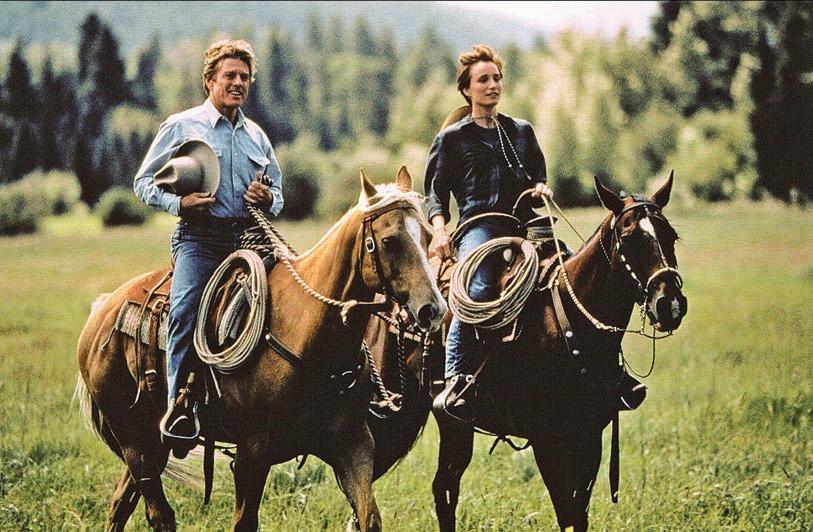
“You know, I always hoped somebody gentle and caring might come along. Years pass. A small town and all. And your hopes begin to fade a little every day until you hardly remember what they were. I’ve seen who you are, Charley. The way you looked after that boy and the respect you give Boss. It might be little bits. But they’re enough for a woman who looks.”


As one IMDB review states, “Open Range doesn’t do anything particularly new, it just does it particularly well.” That’s a familiar refrain in both memorable westerns and classic romances. There may be only so many ways to tell these stories, but when you pair Kevin Costner (who also directs) and Annette Bening, both at their movie star prime, as two people not looking for love but nding something in each other they never expected, it’s an excursion well worth taking again.
Set in 1880s Montana, the lm has both tenderness and violence. Its intensely realistic wide-shot gun ght scenes won critical praise — and its R-rating. The hostilities might be central, but so is the attraction between Charley Waite (Costner) and Sue Barlow (Bening). Their hesitant romance blossoms gradually, like everything else in this leisurely paced tale. Waite, an ex-gunslinger-turned-cowhand, and his boss (Robert Duvall) run afoul of a ruthless cattle baron. A con ict that cannot be resolved will compel Charley, like Alan Ladd in Shane, to return to the violent trade he hoped to escape. It takes a while before the shooting starts, but scenes such as the awkward but endearing moment when Sue serves Charley tea will keep you engaged until the guns are drawn.
“You see, I love you so much I just want you to be happy ... even if that happiness no longer includes me.”
You can’t go wrong with Eastwood in a western. Okay, in this case it’s Scott Eastwood, but Clint’s son looks as good as a cowboy as his dad did when he was headin’ ’em up and movin’ ’em on in Rawhide. Romance enters the picture when he drops his hat at a rodeo and it’s picked up by sophisticated Jersey girl Sophia (Britt Robertson), who will soon be o to Manhattan to study art history.
While it seems like fate is against them, a chance encounter with an elderly man who has loved and lost (well-played by Alan Alda) may inspire the young couple to give their love a chance. If this sounds like a western version of The Notebook, that’s not surprising as The Longest Ride was adapted from a story by Notebook author Nicholas Sparks. It’s a sweet and predictable tale that might be a little too Hallmark Channel for more cynical viewers — you know who you are.
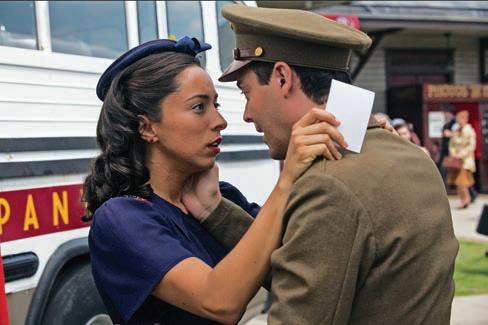
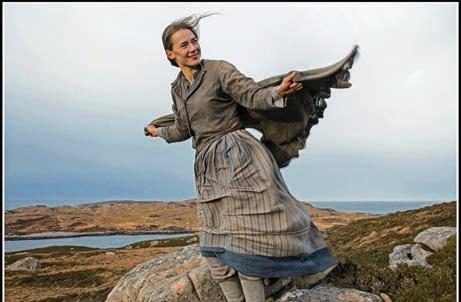
“Once upon a time, 1870 to be exact, a 16-year-old kid traveled from the cold shoulder of Scotland to the baking heart of America to nd his love. His name was Jay. Her name was Rose.”
In the wrong hands this story might not have worked at all. Indeed, some critics shared that assessment — “unintentionally ridiculous” was the verdict of the RogerEbert.com website. But others were swept up in the adventure of baby-faced youth Jay (Kodi Smit-McPhee) braving the many hazards of the American Old West to nd the woman he loves (Caren Pistorius), after she is unfairly exiled from her homeland.
True, the kid looks like he wouldn’t last 10 seconds in Tombstone or Dodge City, so thankfully writer-director John Maclean provides a guide in Silas, a tough hombre played by Michael Fassbender, one of those actors who automatically make any movie better. The result is not a typical western or a typical romance — even the backdrop of New Zealand substituting for Colorado seems more than a bit o . But this works on you, slowly and steadily, until you’ll be as eager as Jay to nd out if his continent-spanning quest of love will be rewarded. H